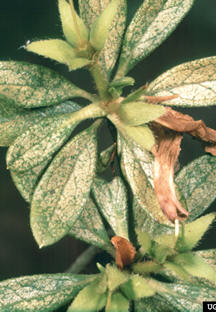Lace Bugs
 DESCRIPTION
DESCRIPTION
A typical adult Lace Bug found on ornamental plants is small (2-5 mm), rectangular, with an overall flattened appearance. The tops of the front wings, head and thorax are membranous, composed of many raised ridges, which give a lacelike appearance; thus the common name Lace Bug. In most species, the adults are cream colored with patches of black or brown. A dark X-shaped mark is apparent on wings of the Azalea and Andromeda Lace Bugs. Nymphs are spiny and much darker than the adults. Nymphs can be found clustered among their dark feces and cast nymphal skins on lower leaf surfaces. When fully grown, nymphs are about one-half the size of the adults. Dark colored eggs are inserted into the midrib on the lower leaf so that only the top of the egg appears above the leaf surface. They are covered with a varnish-like material secreted by the female.
LIFE CYCLE
Lace Bugs that feed on broad-leaved evergreens overwinter in the egg stage. The overwintering eggs that are inserted into the midrib of broad-leaved evergreens the previous fall will hatch from late April through May. Nymphs feed on the lower leaf surface. The complete life cycle from egg to adult may be completed in thirty days under optimal conditions. Two to three generations are common in Pennsylvania. Lace Bugs can be found in all stages of development on broad-leaved evergreens until August or September. In recent years, adult Lace Bugs have been observed into December.
DAMAGE
Both adults and nymphs injure the host by piercing the epidermis of a leaf and sucking fluid from plant tissue. The removal of plant juices causes foliar discoloration, reduced plant vigor and premature leaf drop. Lace Bug damage can sometimes be mistaken for Mite damage. The underside of the leaves will sometimes reveal the nymphs or adults, cast skins and the excrement, which is black with a varnished appearance. When Azalea and Rhododendron are grown in a sunny location, heavy Lace Bug populations and their associated foliar damage may occur. Damage caused by the Andromeda Lace Bug may be severe in either sunny or shady sites.
CONTROL
Formulations of acephate (Orthene), cyfluthrin (Tempo), insecticidal soap, imidicloprid (Merit) and several other insecticides are labeled for Lace Bug control.* Treat when Lace Bugs are first seen. Direct spray to the underside of the leaves to ensure adequate control. Additional applications may be necessary from June through October. Follow all label directions for specific information on host plant label clearance, phytotoxicity information, safety precautions and dosage information.
* See Woody Ornamental Insect, Mite and Disease Management, The Pennsylvania State University (2005) for more details.
WARNING: Pesticides are poisonous. Read and follow directions and safety precautions on labels. Handle carefully and store in original labeled containers out of reach of children, pets and livestock. Dispose of empty containers right away , in a safe manner and place. Do not contaminate forage, streams or ponds.
For professional assistance with tree and shrub problems contact a Keystone arborist
Penn State’s Fact Sheet on Lace Bug


